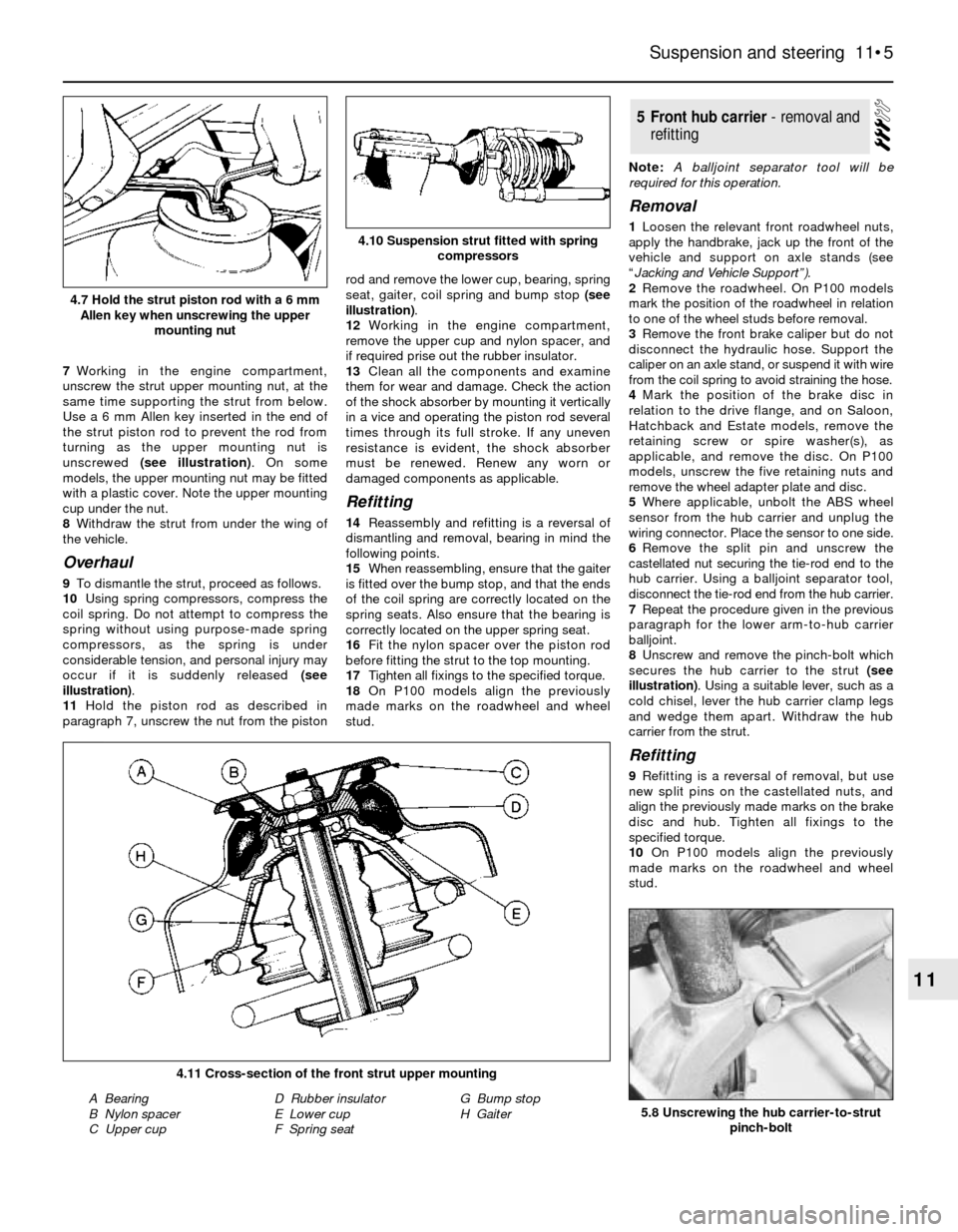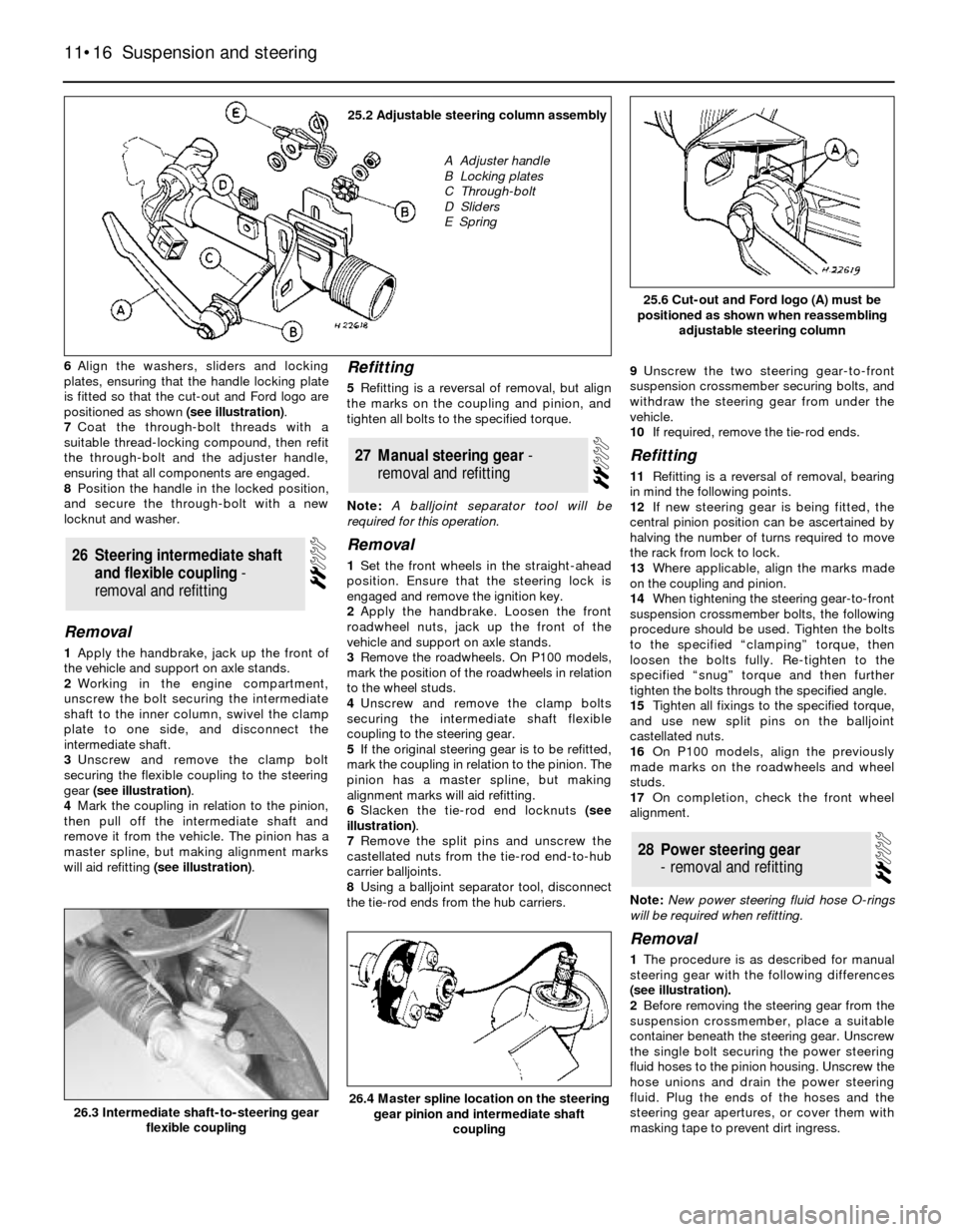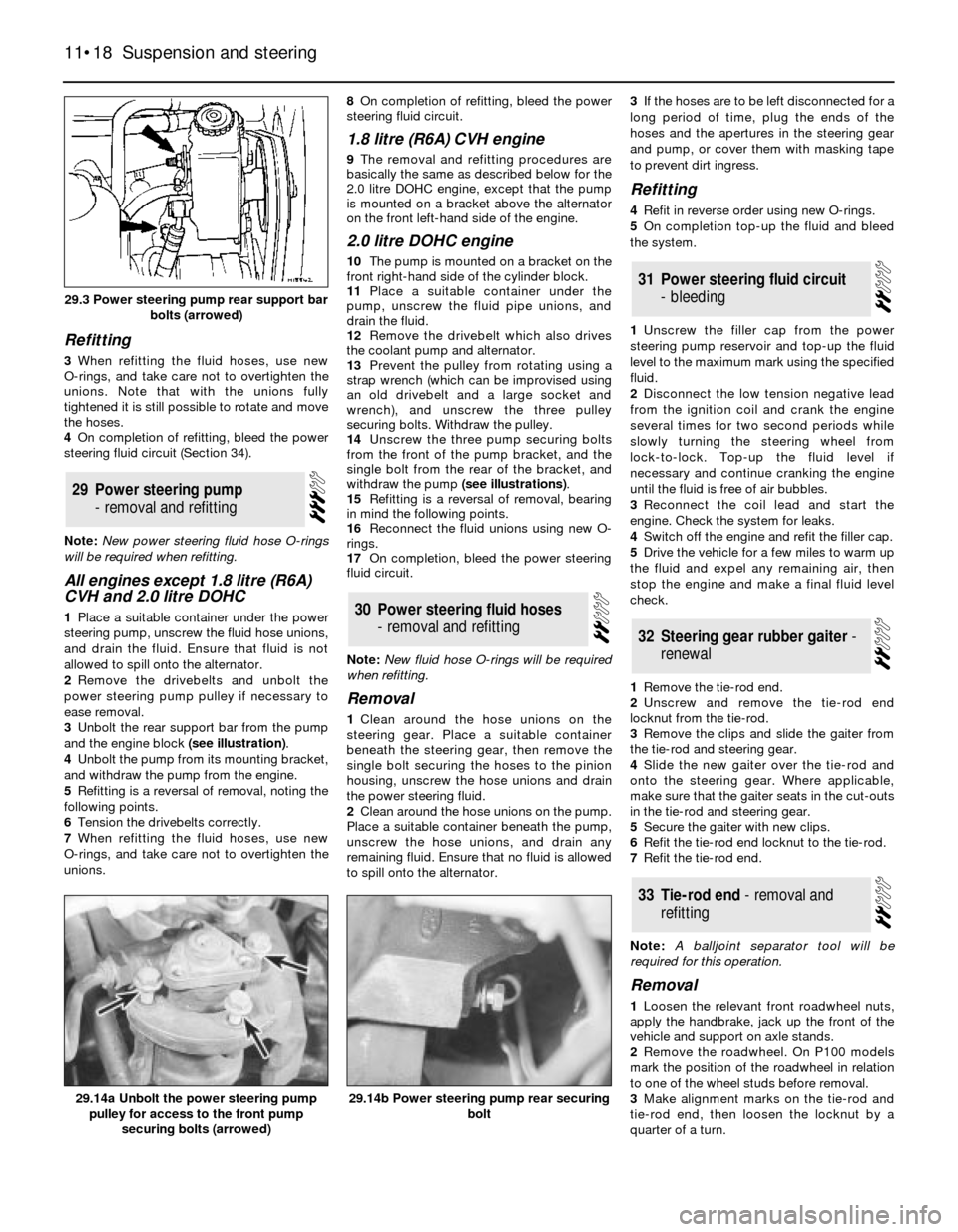check engine FORD SIERRA 1983 1.G Suspension And Steering Workshop Manual
[x] Cancel search | Manufacturer: FORD, Model Year: 1983, Model line: SIERRA, Model: FORD SIERRA 1983 1.GPages: 20, PDF Size: 0.94 MB
Page 5 of 20

7Working in the engine compartment,
unscrew the strut upper mounting nut, at the
same time supporting the strut from below.
Use a 6 mm Allen key inserted in the end of
the strut piston rod to prevent the rod from
turning as the upper mounting nut is
unscrewed (see illustration). On some
models, the upper mounting nut may be fitted
with a plastic cover. Note the upper mounting
cup under the nut.
8Withdraw the strut from under the wing of
the vehicle.
Overhaul
9To dismantle the strut, proceed as follows.
10Using spring compressors, compress the
coil spring. Do not attempt to compress the
spring without using purpose-made spring
compressors, as the spring is under
considerable tension, and personal injury may
occur if it is suddenly released (see
illustration).
11Hold the piston rod as described in
paragraph 7, unscrew the nut from the pistonrod and remove the lower cup, bearing, spring
seat, gaiter, coil spring and bump stop (see
illustration).
12Working in the engine compartment,
remove the upper cup and nylon spacer, and
if required prise out the rubber insulator.
13Clean all the components and examine
them for wear and damage. Check the action
of the shock absorber by mounting it vertically
in a vice and operating the piston rod several
times through its full stroke. If any uneven
resistance is evident, the shock absorber
must be renewed. Renew any worn or
damaged components as applicable.
Refitting
14Reassembly and refitting is a reversal of
dismantling and removal, bearing in mind the
following points.
15When reassembling, ensure that the gaiter
is fitted over the bump stop, and that the ends
of the coil spring are correctly located on the
spring seats. Also ensure that the bearing is
correctly located on the upper spring seat.
16Fit the nylon spacer over the piston rod
before fitting the strut to the top mounting.
17Tighten all fixings to the specified torque.
18On P100 models align the previously
made marks on the roadwheel and wheel
stud.Note: A balljoint separator tool will be
required for this operation.
Removal
1Loosen the relevant front roadwheel nuts,
apply the handbrake, jack up the front of the
vehicle and support on axle stands (see
“Jacking and Vehicle Support”).
2Remove the roadwheel. On P100 models
mark the position of the roadwheel in relation
to one of the wheel studs before removal.
3Remove the front brake caliper but do not
disconnect the hydraulic hose. Support the
caliper on an axle stand, or suspend it with wire
from the coil spring to avoid straining the hose.
4Mark the position of the brake disc in
relation to the drive flange, and on Saloon,
Hatchback and Estate models, remove the
retaining screw or spire washer(s), as
applicable, and remove the disc. On P100
models, unscrew the five retaining nuts and
remove the wheel adapter plate and disc.
5Where applicable, unbolt the ABS wheel
sensor from the hub carrier and unplug the
wiring connector. Place the sensor to one side.
6Remove the split pin and unscrew the
castellated nut securing the tie-rod end to the
hub carrier. Using a balljoint separator tool,
disconnect the tie-rod end from the hub carrier.
7Repeat the procedure given in the previous
paragraph for the lower arm-to-hub carrier
balljoint.
8Unscrew and remove the pinch-bolt which
secures the hub carrier to the strut (see
illustration). Using a suitable lever, such as a
cold chisel, lever the hub carrier clamp legs
and wedge them apart. Withdraw the hub
carrier from the strut.
Refitting
9Refitting is a reversal of removal, but use
new split pins on the castellated nuts, and
align the previously made marks on the brake
disc and hub. Tighten all fixings to the
specified torque.
10On P100 models align the previously
made marks on the roadwheel and wheel
stud.
5Front hub carrier -removaland
refitting
Suspension and steering 11•5
11
5.8 Unscrewing the hub carrier-to-strut
pinch-bolt
4.11 Cross-section of the front strut upper mounting
A Bearing
B Nylon spacer
C Upper cupD Rubber insulator
E Lower cup
F Spring seatG Bump stop
H Gaiter
4.10 Suspension strut fitted with spring
compressors
4.7 Hold the strut piston rod with a 6 mm
Allen key when unscrewing the upper
mounting nut
Page 16 of 20

6Align the washers, sliders and locking
plates, ensuring that the handle locking plate
is fitted so that the cut-out and Ford logo are
positioned as shown (see illustration).
7Coat the through-bolt threads with a
suitable thread-locking compound, then refit
the through-bolt and the adjuster handle,
ensuring that all components are engaged.
8Position the handle in the locked position,
and secure the through-bolt with a new
locknut and washer.
Removal
1Apply the handbrake, jack up the front of
the vehicle and support on axle stands.
2Working in the engine compartment,
unscrew the bolt securing the intermediate
shaft to the inner column, swivel the clamp
plate to one side, and disconnect the
intermediate shaft.
3Unscrew and remove the clamp bolt
securing the flexible coupling to the steering
gear (see illustration).
4Mark the coupling in relation to the pinion,
then pull off the intermediate shaft and
remove it from the vehicle. The pinion has a
master spline, but making alignment marks
will aid refitting (see illustration).
Refitting
5Refitting is a reversal of removal, but align
the marks on the coupling and pinion, and
tighten all bolts to the specified torque.
Note: A balljoint separator tool will be
required for this operation.
Removal
1Set the front wheels in the straight-ahead
position. Ensure that the steering lock is
engaged and remove the ignition key.
2Apply the handbrake. Loosen the front
roadwheel nuts, jack up the front of the
vehicle and support on axle stands.
3Remove the roadwheels. On P100 models,
mark the position of the roadwheels in relation
to the wheel studs.
4Unscrew and remove the clamp bolts
securing the intermediate shaft flexible
coupling to the steering gear.
5If the original steering gear is to be refitted,
mark the coupling in relation to the pinion. The
pinion has a master spline, but making
alignment marks will aid refitting.
6Slacken the tie-rod end locknuts (see
illustration).
7Remove the split pins and unscrew the
castellated nuts from the tie-rod end-to-hub
carrier balljoints.
8Using a balljoint separator tool, disconnect
the tie-rod ends from the hub carriers.9Unscrew the two steering gear-to-front
suspension crossmember securing bolts, and
withdraw the steering gear from under the
vehicle.
10If required, remove the tie-rod ends.
Refitting
11Refitting is a reversal of removal, bearing
in mind the following points.
12If new steering gear is being fitted, the
central pinion position can be ascertained by
halving the number of turns required to move
the rack from lock to lock.
13Where applicable, align the marks made
on the coupling and pinion.
14When tightening the steering gear-to-front
suspension crossmember bolts, the following
procedure should be used. Tighten the bolts
to the specified “clamping” torque, then
loosen the bolts fully. Re-tighten to the
specified “snug” torque and then further
tighten the bolts through the specified angle.
15Tighten all fixings to the specified torque,
and use new split pins on the balljoint
castellated nuts.
16On P100 models, align the previously
made marks on the roadwheels and wheel
studs.
17On completion, check the front wheel
alignment.
Note: New power steering fluid hose O-rings
will be required when refitting.
Removal
1The procedure is as described for manual
steering gear with the following differences
(see illustration).
2Before removing the steering gear from the
suspension crossmember, place a suitable
container beneath the steering gear. Unscrew
the single bolt securing the power steering
fluid hoses to the pinion housing. Unscrew the
hose unions and drain the power steering
fluid. Plug the ends of the hoses and the
steering gear apertures, or cover them with
masking tape to prevent dirt ingress.
28Power steering gear
- removal and refitting
27Manual steering gear -
removaland refitting
26Steering intermediate shaft
and flexible coupling -
removal and refitting
11•16Suspension and steering
25.6 Cut-out and Ford logo (A) must be
positioned as shown when reassembling
adjustable steering column
26.4 Master spline location on the steering
gear pinion and intermediate shaft
coupling26.3 Intermediate shaft-to-steering gear
flexible coupling
25.2 Adjustable steering column assembly
A Adjuster handle
B Locking plates
C Through-bolt
D Sliders
E Spring
Page 18 of 20

Refitting
3When refitting the fluid hoses, use new
O-rings, and take care not to overtighten the
unions. Note that with the unions fully
tightened it is still possible to rotate and move
the hoses.
4On completion of refitting, bleed the power
steering fluid circuit (Section 34).
Note: New power steering fluid hose O-rings
will be required when refitting.
All engines except 1.8 litre (R6A)
CVH and 2.0 litre DOHC
1Place a suitable container under the power
steering pump, unscrew the fluid hose unions,
and drain the fluid. Ensure that fluid is not
allowed to spill onto the alternator.
2Remove the drivebelts and unbolt the
power steering pump pulley if necessary to
ease removal.
3Unbolt the rear support bar from the pump
and the engine block (see illustration).
4Unbolt the pump from its mounting bracket,
and withdraw the pump from the engine.
5Refitting is a reversal of removal, noting the
following points.
6Tension the drivebelts correctly.
7When refitting the fluid hoses, use new
O-rings, and take care not to overtighten the
unions. 8On completion of refitting, bleed the power
steering fluid circuit.
1.8 litre (R6A) CVH engine
9The removal and refitting procedures are
basically the same as described below for the
2.0 litre DOHC engine, except that the pump
is mounted on a bracket above the alternator
on the front left-hand side of the engine.
2.0 litre DOHC engine
10The pump is mounted on a bracket on the
front right-hand side of the cylinder block.
11Place a suitable container under the
pump, unscrew the fluid pipe unions, and
drain the fluid.
12Remove the drivebelt which also drives
the coolant pump and alternator.
13Prevent the pulley from rotating using a
strap wrench (which can be improvised using
an old drivebelt and a large socket and
wrench), and unscrew the three pulley
securing bolts. Withdraw the pulley.
14Unscrew the three pump securing bolts
from the front of the pump bracket, and the
single bolt from the rear of the bracket, and
withdraw the pump (see illustrations).
15Refitting is a reversal of removal, bearing
in mind the following points.
16Reconnect the fluid unions using new O-
rings.
17On completion, bleed the power steering
fluid circuit.
Note: New fluid hose O-rings will be required
when refitting.
Removal
1Clean around the hose unions on the
steering gear. Place a suitable container
beneath the steering gear, then remove the
single bolt securing the hoses to the pinion
housing, unscrew the hose unions and drain
the power steering fluid.
2Clean around the hose unions on the pump.
Place a suitable container beneath the pump,
unscrew the hose unions, and drain any
remaining fluid. Ensure that no fluid is allowed
to spill onto the alternator.3If the hoses are to be left disconnected for a
long period of time, plug the ends of the
hoses and the apertures in the steering gear
and pump, or cover them with masking tape
to prevent dirt ingress.
Refitting
4Refit in reverse order using new O-rings.
5On completion top-up the fluid and bleed
the system.
1Unscrew the filler cap from the power
steering pump reservoir and top-up the fluid
level to the maximum mark using the specified
fluid.
2Disconnect the low tension negative lead
from the ignition coil and crank the engine
several times for two second periods while
slowly turning the steering wheel from
lock-to-lock. Top-up the fluid level if
necessary and continue cranking the engine
until the fluid is free of air bubbles.
3Reconnect the coil lead and start the
engine. Check the system for leaks.
4Switch off the engine and refit the filler cap.
5Drive the vehicle for a few miles to warm up
the fluid and expel any remaining air, then
stop the engine and make a final fluid level
check.
1Remove the tie-rod end.
2Unscrew and remove the tie-rod end
locknut from the tie-rod.
3Remove the clips and slide the gaiter from
the tie-rod and steering gear.
4Slide the new gaiter over the tie-rod and
onto the steering gear. Where applicable,
make sure that the gaiter seats in the cut-outs
in the tie-rod and steering gear.
5Secure the gaiter with new clips.
6Refit the tie-rod end locknut to the tie-rod.
7Refit the tie-rod end.
Note: A balljoint separator tool will be
required for this operation.
Removal
1Loosen the relevant front roadwheel nuts,
apply the handbrake, jack up the front of the
vehicle and support on axle stands.
2Remove the roadwheel. On P100 models
mark the position of the roadwheel in relation
to one of the wheel studs before removal.
3Make alignment marks on the tie-rod and
tie-rod end, then loosen the locknut by a
quarter of a turn.
33Tie-rod end - removal and
refitting
32Steering gear rubber gaiter -
renewal
31Power steering fluid circuit
- bleeding
30Power steering fluid hoses
- removal and refitting
29Power steering pump
- removal and refitting
11•18Suspension and steering
29.3 Power steering pump rear support bar
bolts (arrowed)
29.14b Power steering pump rear securing
bolt29.14a Unbolt the power steering pump
pulley for access to the front pump
securing bolts (arrowed)